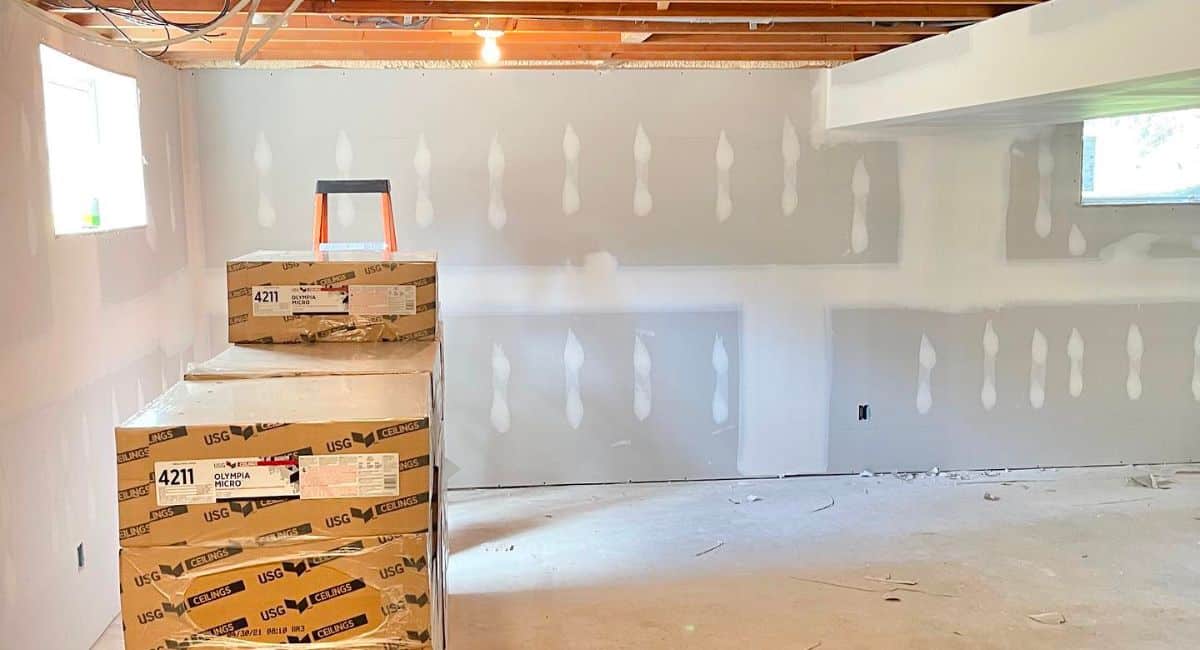When it comes to transforming your basement into a cozy and inviting living space, drywall is your best friend. But what exactly is drywall? At its core, drywall consists of a layer of gypsum, a mineral known for its fire-resistant properties, sandwiched between two sheets of paper. This combination results in a material that’s not only affordable and easy to install but also provides a smooth, durable surface that’s ready to be painted or wallpapered to your heart’s content.
The benefits of using drywall in your basement are numerous. For starters, it adds a clean, finished look to what might otherwise be a dark and dreary space. But the advantages don’t stop there. Drywall also enhances the insulation and soundproofing of your basement, turning it into a cozy retreat that feels just like any other room in your home.
However, it’s important to note that the key to reaping all these benefits lies in proper installation. A shoddy drywall job can lead to a host of problems down the line, from unsightly cracks and holes to more serious issues like mold and structural damage. That’s why it’s crucial to take the time to do it right, or better yet, call in drywall professionals to ensure the job is done to perfection.
But if you’re eager to give it a shot yourself, let’s dive in and explore the step-by-step process of transforming your basement with drywall installation
Preparing For Drywall Installation
Tools and Materials You’ll Need
Before we dive into the nitty-gritty of drywall installation, let’s first make sure we have all the necessary tools and materials on hand. For this project, you’ll need:
| Drywall sheets (moisture-resistant drywall is best for basements – Learn More Here) | Utility knife |
| Tape measure | Straightedge |
| Pencil | Drywall screws |
| Screwdriver or drill with a screwdriver bit | Drywall saw |
| Joint compound | Sandpaper |
| Ladder or scaffolding (for reaching the ceiling) | Moisture meter |
With your toolkit ready, you’re all set to start the installation process.
Addressing Moisture Issues
Basements are notorious for their dampness, and moisture is the archenemy of drywall. Before you even think about hanging that first sheet of drywall, it’s important to address any moisture issues. Start by inspecting the walls and floors for signs of water infiltration or leaks.
If you spot any, take the necessary steps to fix the problem, whether that means repairing cracks, installing a vapor barrier, or improving the basement’s drainage system.
A moisture meter can be a handy tool in this step, helping you measure the moisture levels in the walls and floors to ensure they’re within acceptable limits.
Cleaning and Clearing the Space
Once you’ve tackled the moisture, it’s time to prep the space. Clear out any items from the basement and give it a good clean. Sweep the floor, vacuum any dust or dirt, and make sure your space is free of any mold or mildew.
Remember, a clean and clear space is essential for a smooth installation process.
Repairing Damages
Before we move on to the fun part, take a moment to inspect the basement for any damages. Look out for small cracks or water damage, and address them promptly. Fill in cracks with joint compound and replace any damaged sections of the wall. Trust us, taking the time to repair any damages now will save you a lot of headaches in the future.
Now that you’ve got your tools and materials ready and the space prepped, you’re all set to start the installation process.
Installing the Drywall
Measuring and Cutting the Drywall
It’s time to dive into the installation process. First up, measuring and cutting the drywall. This step is crucial as it ensures a proper fit and minimizes waste. Here’s how to do it:
- Start by measuring the height and width of each wall, taking note of any openings such as windows and doors.
- Transfer these measurements onto your drywall sheets, marking them with a pencil.
- Using a straightedge, align it with your pencil marks and score the drywall with your utility knife.
- Snap the drywall along the scored line, then cut through the paper on the other side to separate the pieces.
- For any electrical outlets or switches, measure their location and mark them on the drywall. Use your drywall saw to cut out the necessary openings.
Remember, measure twice and cut once to avoid any mistakes. And don’t forget to label each piece of drywall according to its location to make installation a breeze.
Attaching the Drywall to the Walls
With our drywall cut and ready to go, it’s time to attach it to the walls. Here’s what you’ll need:
- Drill
- Drywall screws
- Level
And here’s how to do it:
- Start by positioning the first piece of drywall on the wall, making sure the edges align with the studs.
- Using your drill, secure the drywall to the studs with drywall screws, spacing them about 12 inches apart.
- Make sure to sink the screws just below the surface of the drywall, but be careful not to break the paper.
- Use your level to ensure the drywall is straight and plumb.
- Repeat this process for the remaining pieces of drywall, making sure the edges meet on a stud and the joints are as tight as possible.
Securing the Drywall to the Ceiling
Once the walls are done, it’s time to move on to the ceiling. This step is similar to the walls, but can be rather tricky for DIYers as working with drywall sheets above your head can be challenging. Be very careful during this step.
- Measure the distance between the ceiling joists and mark the locations on the drywall.
- Using your drill, secure the drywall to the ceiling joists with screws, spacing them about 12 inches apart.
- Make sure the screws are sunk just below the surface of the drywall, but again, be careful not to break the paper.
- Double-check the entire ceiling to ensure there are no loose or uneven spots.
And there you have it! Your drywall is now securely attached to the walls and ceiling, and you’re one step closer to a finished basement.
Finishing and Painting
Taping and Mudding the Seams
With the drywall securely in place, it’s time to move on to taping and mudding the seams. This step is crucial for achieving a smooth, seamless finish. Here’s how to do it:
- Start by applying a thin layer of joint compound along the seams.
- Cut a length of drywall tape to fit and press it into the compound, making sure there are no bubbles or wrinkles.
- Use a taping knife to smooth out the tape, removing any excess compound.
- Allow the compound to dry completely, then sand it lightly to remove any bumps or ridges.
- Apply a second coat of compound, feathering it out beyond the edges of the first coat to blend it into the surrounding drywall.
- Apply a think layer of compound over each drywall screw.
- Once the second coat is dry, sand it smooth and wipe away any dust with a damp cloth.
Sanding the Drywall
Now that the seams are taped and mudded, it’s time to sand the drywall to create a smooth, even surface for painting. Here’s what you’ll need:
- Sandpaper (start with a coarser grit and move to a finer grit as you go)
- Sanding block or pole sander
- Dust mask
- Safety glasses
And here’s how to do it:
- Start by sanding the seams and any other areas where the joint compound was applied, using a coarser grit sandpaper.
- Once the seams are smooth, switch to a finer grit sandpaper and sand the surface of the drywall.
- Be sure to wear a dust mask and safety glasses to protect yourself from the fine dust particles.
- Wipe away any dust with a damp cloth before moving on to the next step.
Priming and Painting
The final step in the process is priming and painting the drywall. Here’s what you’ll need:
- Primer (choose one that’s suitable for drywall)
- Paint (opt for a paint that’s specifically formulated for drywall and is durable)
- Paint roller or brush
- Painter’s tape
- Drop cloths
Here’s how to do it:
- Start by applying a coat of primer to the drywall, using a roller or brush. Make sure to cover the entire surface evenly.
- Allow the primer to dry completely before moving on to the paint.
- Once the primer is dry, choose your paint color and start painting. Apply the paint in even coats, allowing each coat to dry before applying the next.
- Use painter’s tape to achieve clean edges and protect the floor and furniture with drop cloths.
And there you have it! Your basement is now transformed into a beautiful, finished space that’s ready to be enjoyed. With a little patience and attention to detail, you’ve successfully drywalled your basement like a pro. Congratulations!
Final Takeaways: Drywalling Your Basement Like A Pro
Proper drywall installation is one of the cornerstones of a finished and functional basement that not only adds value to your home but also provides additional living space for you and your family to enjoy. The smooth, insulated walls create a cozy and inviting atmosphere, turning your basement into a true extension of your home.
If you’re located in Edmonton, Alberta, and prefer professional drywall installation, look no further than Drytech Interiors. Our team of experienced and skilled professionals is ready to tackle any drywall project, big or small, ensuring the job is done right the first time. We pride ourselves on our attention to detail and commitment to customer satisfaction, so you can rest assured that your basement is in good hands.
For those not located in Edmonton, we encourage you to reach out to a reputable drywall contractor in your area. A professional will have the knowledge and expertise to handle the job, ensuring your basement is transformed into the beautiful, functional space you’ve always dreamed of.
So, what are you waiting for? Take the first step towards a finished basement today! Contact us to learn more about our services and how we can help you achieve the basement of your dreams.

